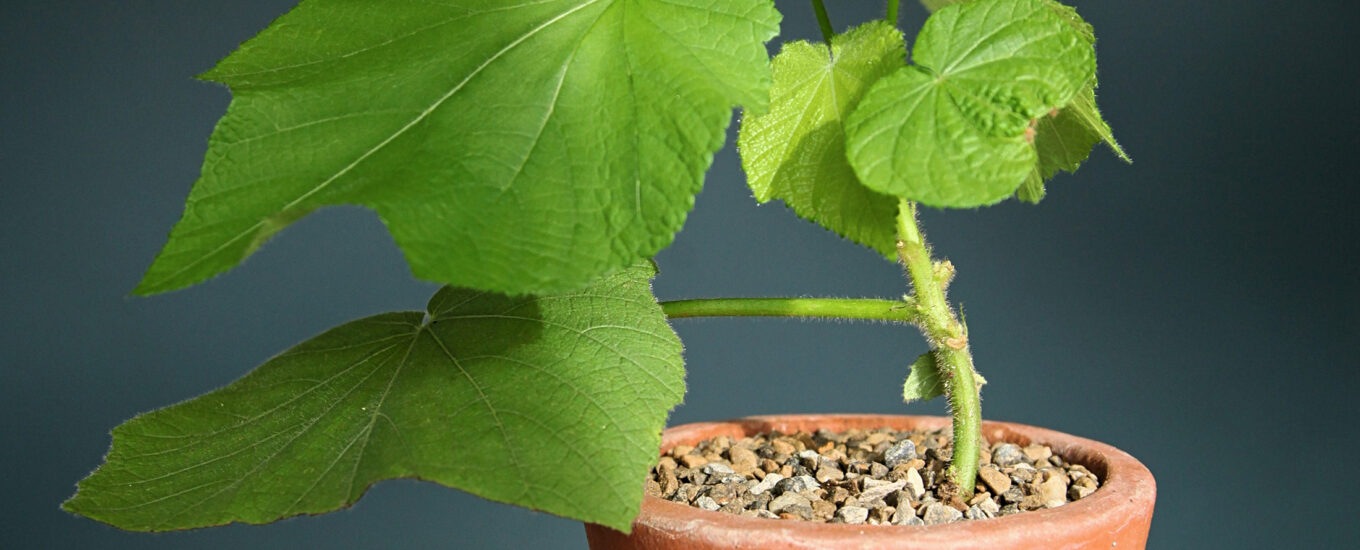The Puzzle of Lucian Freud’s Zimmerlinde
STORIES

By Christopher Woodward, Garden Museum Director ‘This plant escaped the Nazis’ I said to my mother on the platform of Ampthill railway station. My mother, a psychotherapist, has volunteered to join the expedition to the greenhouse of the designer Todd Longstaffe-Gowan to collect a cutting from a zimmerlinde descended from the one which grew in Sigmund Freud’s apartment from Vienna. It was inherited by his grandson Lucian Freud, who left it to David Dawson, the painter who worked as Freud’s studio assistant and who inherited his house in Kensington. That zimmerlinde grows tall at the entrance to Freud’s garden, re-designed by Longstaffe-Gowan. Dawson gave him a cutting. And Todd, in turn, gave us the cutting which we transported to London. It is now a statuesque plant, second prize in our raffle in support of the Freud exhibition. It has, perhaps, one of the most distinguished provenances of any houseplant in the world. And if you enter our raffle by Sunday 5 March you have a chance to win the plant grown from this newest cutting.

The zimmerlinde is also a key to understanding Lucian Freud’s relationship to plants, and to family. I’d never heard of such a plant until Dr Giovanni Aloi, who has curated our exhibition, published Lucian Freud Herbarium in 2019. Sparmannia africana is a plant which widens as it grows tall, with leaves of a calm, hovering green. It is the subject of one of the masterpieces of the exhibition Lucian Freud: Plant Portraits, dedicated – but perhaps never given – to his second wife Caroline Blackwood, which appeared, unknown, at Christie’s in 2018, and has been lent to us from a private collection in the United States. He would paint the same plant for decades.

To his eldest daughter the poet Annie Freud ‘certain plants meant something to him’. And the zimmerlinde reminded him of the first eleven years of his life. His parents Ernst and Lucie had one in their flat in Berlin. So did his maternal grandmother in Charlottenhof. And so did Sigmund at Bergstrasse, 19, Vienna. That one was the parent of Lucian’s plant. Or so Lucian said. But would Sigmund have escaped Vienna with a houseplant under his arm, a friend wondered aloud? So back to William Feaver’s epic biography of Lucian Freud. And he gives a rival provenance: the Hamlyn family. In Berlin, Freud’s neighbour and doctor was Professor Hamburger, who also left for England in 1933. One of his sons, and Lucian’s playmate, became the publisher and philanthropist Paul Hamlyn; his brother, Michael Hamburger, the poet and translator (whose orchard would in time become the subject of a very beautiful film by Tacita Dean). And it is Hamburger who wrote to Feaver that when Lucian wanted a plant, in 1947, it was to their house he came. In fact, he took several: they are hard to propagate. ‘They were very common in Germany but I think unknown when we came to England. The original was raised from a leaf sent by post from Germany to my mother’. (Paul Hamlyn would also live with potted zimmerlinde all his life). But you can’t raise a zimmerlinde from a leaf sent in the post, questions Aloi, something of a houseplant virtuoso himself. But it would have been possible for Sigmund to pack the plant for the train journey from Vienna to London, together with the Egyptian artefacts and couch you see in the Freud Museum in Hampstead today. So perhaps we will never know whether the ‘parent’ of Lucian’s zimmerlinde was Dr Freud’s from Vienna or from the Hamburgers in Berlin. Either way, it’s a pretty distinguished provenance. And to Aloi the deeper truth is that Lucian, came to believe that it was grandfather’s, so formed part of his own identity, about which he was both evasive and proud. We all, after all, need a dash of illusion in our self. Why does this pot plant matter to the Garden Museum? Because our Museum is about how people express themselves through plants, and the modesty and care which plants require from us, and about the tiny but epic journeys of domestic life. And because horticultural tenderness can reach across the years. Last month I was reading Robert Byron’s Road to Oxiana. He arrived in Jaffa in September 1933 disembarking at a makeshift port in a heavy swell, in a queue of Jewish refugees from central Europe. One was sick on Byron’s hand. ‘Her husband nursed their child while supporting in his other hand a tall plant of veronica in a pot’. And another houseplant story makes a happy ending to our exhibition. Susanne Dell, a Museum visitor, recently wrote in: ‘My parents, like the Freuds, came here in the thirties as refugees from Hitler, and the Zimmerlinde was always present in the sitting room. It is still lovely and in good health. I’m not sure how old it is, but it was going strong when my mother died sixty years ago. I am in my nineties. Would you like it?’ We may never have a Freud painting in our collection. But in our conservatory, we will have a houseplant which escaped Hitler.
—